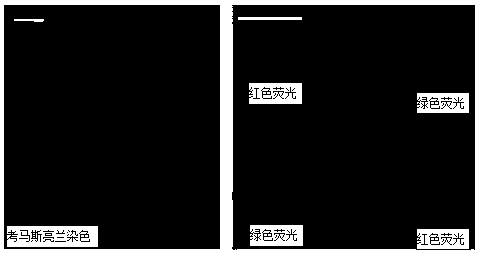Adenovirus chip
An adenovirus and chip technology, applied in the field of biomedicine, can solve the problems of large consumption of reagents, increased mutual pollution, and high product prices, and achieve the effects of less mutual pollution, reliable data, and reduced differences
- Summary
- Abstract
- Description
- Claims
- Application Information
AI Technical Summary
Problems solved by technology
Method used
Image
Examples
Embodiment 1
[0044] Example 1. Preparation of adenovirus chip
[0045] (1). Vector preparation
[0046] General microscope slides can be used as carriers. Slides were first immersed in 25 μg / mL nitrocellulose in methanol, then allowed to evaporate the methanol under aseptic conditions, and dried.
[0047] (2). Adenovirus preparation
[0048] It mainly includes the preparation of adenovirus plasmid vector and the packaging production of adenovirus.
[0049] 1) Each human gene clone is first amplified with ORF primers, cloned into a shuttle vector by a high-throughput method, and then recombined into an adenovirus backbone vector by a high-throughput method.
[0050] 2) Packaging of adenovirus. After linearization, the adenovirus carrying the human gene was added to the wells of a 6-well plate together with the transfection reagent, and cultured for 13 days. Afterwards, the cells were scraped off, centrifuged at a low speed of 2000 rpm, added 1 ml of PBS buffer, and frozen and thawe...
Embodiment 2
[0055] Example 2. Converting Adenovirus Chips to Protein Chips
[0056] Put the adenovirus chip into the petri dish, add 1×10 6 Cells (such as HEK293 cells, CHO cells), 8-10 hours, 37 degrees, 5% carbon dioxide culture. Then add fresh culture medium. According to different experimental requirements, the cells can be treated differently.
[0057] The manipulation of cells is a common skill in the art.
Embodiment 3
[0058] Example 3 . Addition and detection of fluorescent markers on adenovirus chip
[0059] (1) When making shuttle vectors and adenovirus clones, the foreign gene and green fluorescent protein (GFP) are healed together. When cells are added to the chip and cells are transfected, fluorescence can be directly observed under a fluorescence microscope. Alternatively, GFP can also be expressed in the same vector with different promoters or by using IRES. Both fluorescence and color can be obtained with high-throughput scanning microscopy techniques.
[0060] (2) Use different labels or pigments to mark small molecular compounds, proteins or other substances for detection. For example, to measure the binding of a cell surface receptor (Receptor) and a ligand (Ligand), the ligand can be labeled with different fluorescent substances or pigments. When adding cells to the adenovirus chip, the labeled ligand is also added at the same time. When a ligand binds to a receptor in th...
PUM
 Login to View More
Login to View More Abstract
Description
Claims
Application Information
 Login to View More
Login to View More - R&D
- Intellectual Property
- Life Sciences
- Materials
- Tech Scout
- Unparalleled Data Quality
- Higher Quality Content
- 60% Fewer Hallucinations
Browse by: Latest US Patents, China's latest patents, Technical Efficacy Thesaurus, Application Domain, Technology Topic, Popular Technical Reports.
© 2025 PatSnap. All rights reserved.Legal|Privacy policy|Modern Slavery Act Transparency Statement|Sitemap|About US| Contact US: help@patsnap.com



